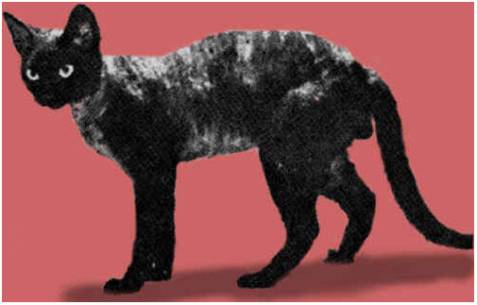
Boonland
Devon Rex
Home Introduction-TheDevons-Kittens Planning Links Email, click here
An
introduction for experienced Devon Rex breeders

The
beginning of the Devon Rex breed was a cat called Kirlee, but how did the breed
expand after his first litters? Yes indeed; via outcrossing!!
Have
a look at any DRX-pedigree on Pawpeds (click foundation) and you’ll find that
there are LOTS of breeds used for expanding of the DRX-breed; the Abyssinian,
American Shorthair, Asian , Balinese, British Shorthair, Burmese, Burmilla,
Cornish Rex, Exotic, Persian, Russian Blue, Siamese, Somali, Sphynx and the
regular housecat.(xsh).
Why
do we need to keep on outcrossing?
Good
question.
Inbreeding Depression:
Loss
of vigour due to the homozygosity of an increasing number of genes. The
inter-breeding of related cats, generation after generation, increases the
probability that the offspring inherits identical genes, over and over again.
This may result in an individual with a smaller variety of different genes in
its makeup. This in turn leads to the immune system becoming less effective.
Cats can only produce antibodies with the genes they have, the smaller the
number of different genes, the smaller the number of different antibodies
produced. The ability of an animal to generate antibodies is drastically reduced
if it loses its genetic diversity, in other words, comes from a small gene pool.
There may be greater proneness to illness, with longer recovery times. Kittens
may be smaller, lethargic, with poor growth, or stillborn. Reproductive
performance may be compromised.
In
short: all the things we don’t want for our cats!
I
would say, strike the golden mean and regularly introduce new, unrelated cats/
breeds into the Devon Rex population preferably avoiding those breeds which are
at present struggling so much with difficult health issues. Always cross
offspring back to well-typed Devon Rex though. All this will help refresh the
gene pool and increase vigour, without too big a risk of losing the type.
Remember though: to get healthy, sweet-tempered offspring, the parents have to
be richly endowed with these ingredients for starters.
A
word of warning here! These latter practices are definitely not advisable for
new breeders. One has to be very familiar with the “feel” of the breed
standard and it would be a sad thing if one gets demotivated because of bad
outcomes. There is a bigger danger of that compared to F1 x DRX-matings.
How
do I go about it?
First
of all;
make inquiries with your cat club about their rules on outcrossing. Not all
clubs will allow it and rules on what breeds to outcross to, vary from country
to country.
Work
a lot on cooperating
with trusted co-breeders. Two or three know more then one and practical and
“mental” advice and support is like the air we breath: without it we
suffocate and die an early death. No one can support a innovating
breedingprogramme and make it work in a substantial way on their own! But if you
cannot find anyone to support your plans right away, do get started on your own.
Good work and advice will always create more good work.
As
in “regular” breeding there are always many choices to be made.
1.
health,
2.
temperament,
3.
type, consisting of headtype, bodytype and last but not least:
coatstructure
4.
good fertility and motherhood
5.
blood groups,
6.
colouring of the parents.
These
“ingredients” can make or break a new litter.
1.We
all know every breed can have it’s health problems,
the DRX is no exception. (Myopathy, Patellar Luxation f.i.) Make sure your DRX
is nice and healthy. I personally have my breedingcats tested for Patellar
Luxation, HCM & PKD (the latter 2 via ultrasound) as these diseases have
been found in the breed and are hereditary. My club always requires a negative
Felv/Fiv test.
2.
choose a sweet-tempered, inquisitive set of partners.
3.
of course it’s important
to always use breeding animals that have proven themselves in this matter or
come from lines that are reliable.
4.
always make the choice of the DRX-parent a well-typed one,
so get to know the Devon type well! Go to shows and talk to judges, visit
experienced breeders and compare notes and details with them. A good DRX-type
gives us the biggest chance of the type not being snowed under by the type of
the other breed. The same goes when mating a regular DRX to an F1 or F2 DRX. For
further breeding, always use the most typefull offspring!
Furthermore
the European Shorthair (Scandinavian Countries are well stocked), Burmese,
Asian (in the UK), Abyssinian & Somali, American
Shorthair (if used exclusively, like is done in the USA, the offspring may
start looking too much like the AS), British Shorthair, Exotic (Persian)
and the “old” Siamese. They all have the obvious
bodytraits-disadvantages that clash with the DRX: too stocky, too slender, too
square, tails too short or long and so on.
A
big no-no is:
Sphynx (or other bald cats). Because the
genepool of this breed was broadened with Devon Rex, both Devon Rex and Sphynx
may carry some of the other breeds genes, causing hairy Sphynx and bald Devon
Rex, not really helpful therefore.
Headtype
The
preferred headshape is triangular, a nosedip is present (not straight or Roman),
flat skull, ears preferably not high-set and as big as possible. Again a good
starting point is to find out if your DRX-parent’s head may need improving: if
the muzzle could be shorter; a Brit may help, is the face too narrow: an Exotic
may help or vice versa.
Coat
Obviousely
a shorthair always is first choice.Some
DRX are longhairgene-carriers and longhair kittens are born regularly, if not
too often. (Fortunately this does not have to bother kittenbuyers, not at all,
the longhairs often have special fans.) The breedstandard does not allow
longhairs though.
5.
do their blood groups add up? Any
DRX-breeder has to know how to work with the different bloodgroups. About
45/50% of the DRX already has bloodtype b, so if you don’t know about it,
learn it first! (see extra info below)
6
if your challenge is to get new colours or more outspoken patterns into
the DRX-breed: please go ahead, but try not to forget about all the other
important factors mentioned above. Whatever the outcome of your colouringwork
may be: please be comforted by the thought that there are lovers for any colour
and you may be contented with your effort for uplifting the breed in many more
important ways.
First
of all, make notes at birth, specifically about headshape, muzzleshape &
presence of dip.Then, do not make a definite choice before the age of 8 or 9
weeks!! The type will then have set a little.
In
F1’s try to look
beyond the smooth hairs for headtype, eyes and eyeset, earset &-size,
muzzleshape and length, skullshape (rounded or flat) and bodystructure and size
(not too stocky?) But, do not be too picky. Look ahead and imagine a good
DRX-partner to make improvements.
F2’s
are more prone to
have a better type, but this is not a rule!
I
can only tell you about my clubrules Felikat, a Fife-member.All kittens of
approved matings will get a certificate of origin. It looks exactly like a
normal pedigree. The cat is registered in the Riex. (addition to the official
pedigree database)
For
F1’s goes:
permission for breeding is required.
F2’s
can be officially admitted to the breed. After permission from the registrar, an F2 (at least 3
months old) can be judged on a show by two separate judges
for breed-likeness (controlclass). The signed report can be send to the
registrar, together with the certificate of origin and your kitten will be
baptized: Devon Rex and you’ll get another certificate of origin denominating
your kitten Devon Rex and not XSH (unknown/unregistered shorthair)
of some cats in my outcross-programme
| Dad Eur( former housecat) | mum DRX | daughter F1 | granddaughter F2 (Full DRX) |
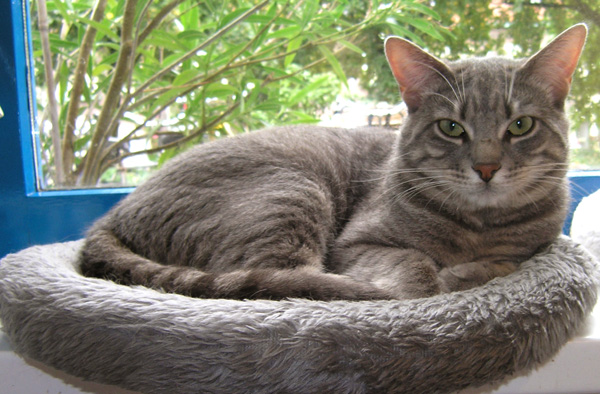 |
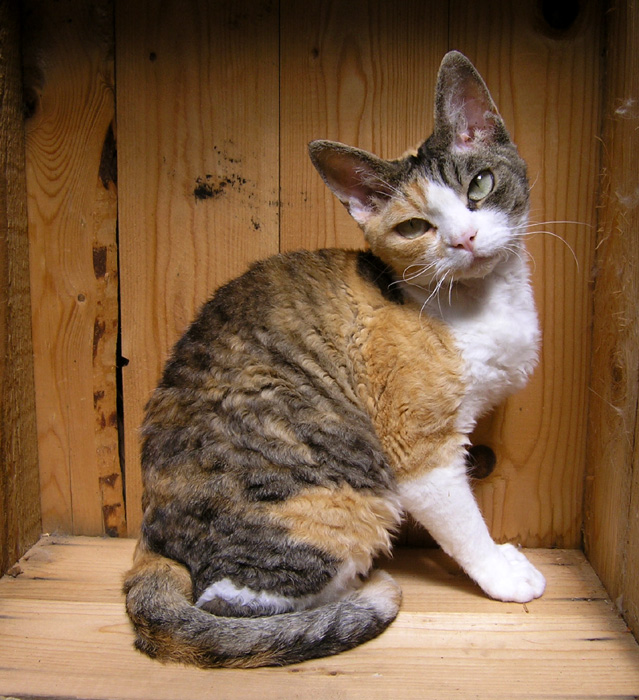 |
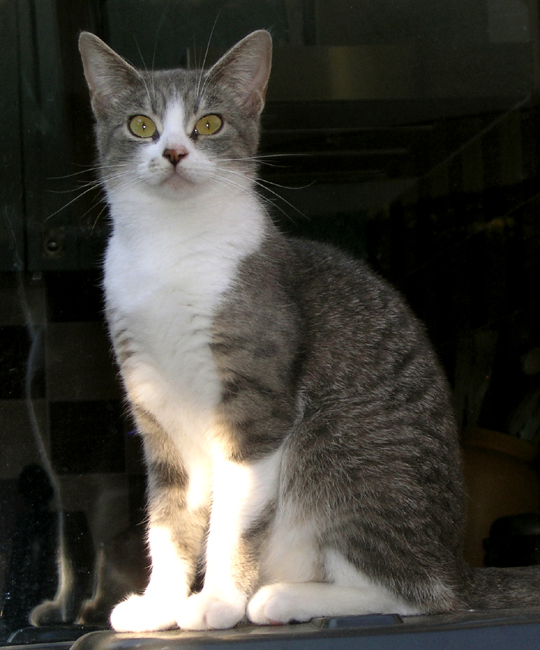 |
mini.jpg) |
| Barney | Karlijntje van Sophal's Choice | Boonland's Pebbles | Boonland's Catootje |
| ▼ daughter | |||
| Dad F1 DRX/Asian | mum DRX | son DRX F2(Full DRX) | daughter F2 DRX (see above) |
|
|
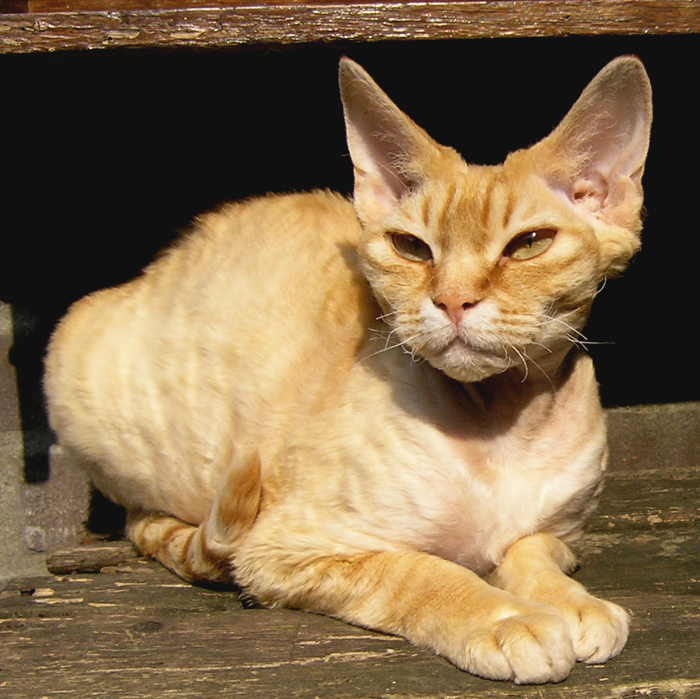 |
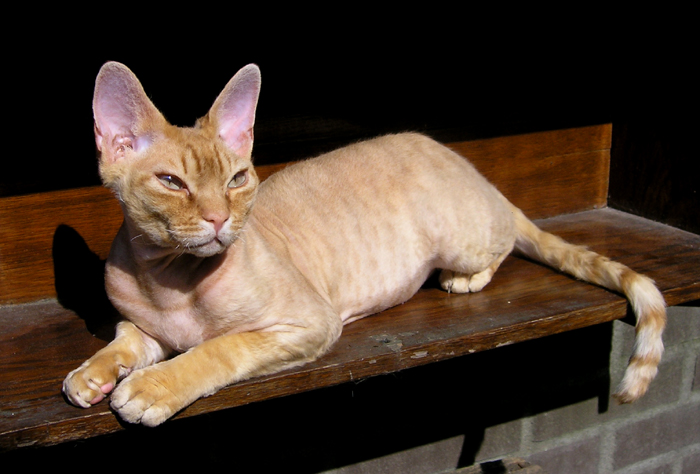 |
mini.jpg) |
| Cloudborn Hyperbole | Ch. Boonland's Ginger Rogers | Ch. Boonland's Curly Dundee | Boonland's Catootje |
More
pictures and info ont these cats can be found here: click
For
more information on DRX-outcrossing,
PROS AND CONS OF INBREEDING
Copyright 1996, 2001, 2003 Sarah Hartwell
|
|
PROS |
CONS |
|
INBREEDING |
Produces
uniform or predictable offspring. |
Doubles
up on faults and weaknesses. |
|
LINE-BREEDING |
Avoid
inbreeding of very closely-related cats, but cats are still
"pure". |
Require
excellent individuals. |
|
OUTCROSSING
(Mating
of unrelated individuals within the same breed) |
Brings
in new qualities or reintroduces lost qualities. |
Less
consistency and predictability of offspring. |
|
HYBRIDIZATION
(Mating
of unrelated individuals of different breeds) |
Brings
in new qualities or reintroduces lost qualities. |
Unpredictable
- new traits may not all be desirable. |
footnote
1:
One
last word:
I
do not pretend to have all the knowledge necessary to be a successful
outcrossbreeder. Driven by the need to help our charming, special breed become
more resilient and vital, I started my own outcross-programme and along the way
tried to get as much information as possible from experienced, wise Devon Rex (outcross)-breeders.
Go
ahead, take the plunge and good luck to you all!
Marjan Boonen
“No
man is an Island “: John Donne (1572-1631)
Many
thanks to all those co-breeders for trusting & helping me.
Special
thanks to Pam Dowling of Madcap Cattery, New Zealand